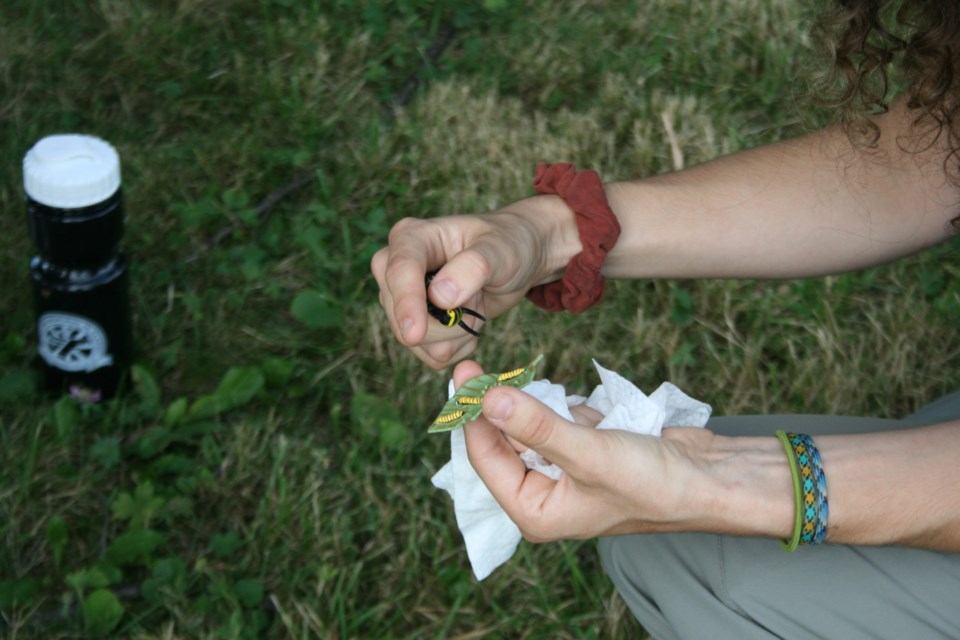Armed with laminated information sheets and her uncle’s magnifying glass, Natalia Srigley turned over milkweed leaves in a field at the Commons until she discovered a Monarch butterfly egg. The St. Catharines girl jumped up and down in delight.
Natalia, her younger sister Emily and her father Nathan, along with another eight relatives and friends in their social bubble, participated in the first ever Parks Canada National Flight of the Monarch Day Tour Saturday. The walk through the historic Niagara-on-the-Lake Commons was part of a nation-wide drive to have Canada recognize the iconic Monarch butterfly on Aug. 22 each year.
Public Outreach Education Officers Joel Forget and Veronica McKelvey were the enthusiastic tour guides. Some of that enthusiasm could have derived from the tour being the first event that they were able to conduct all summer from their post at Fort George.
“We’re really happy to be able to run an event on our sites right now,” says Forget, “so we can continue to educate the public and to continue our mandate at Parks Canada.”
A total of 34 participants took part in the just-over-one-hour tour in two shifts Saturday morning. It began at the Agora building, where a War of 1812 reenactor delivered a greeting before turning things over to Forget and McKelvey.
McKelvey stressed the importance of awareness of species at risk, pointing out that in 2013, the Monarch butterfly population dropped almost 95 per cent. Much of the immersive experience involved the two leaders educating the participants on ways that they could aid in the continued growth of the population of the species in future years.
After reminding everyone to stay physically distanced, which to McKelvey means at least 18 Monarchs apart, the walk toward the Commons began.
At the first stop, one tour-taker was the first to spot a Monarch fluttering past the gathering. Here, under a shady tree on a beautiful morning, McKelvey and Forget led the participants through an interactive discussion of the lifecycle and eating habits of the insect. The children had a lot of questions and comments when the guides revealed their caterpillar and chrysalis models.
Unique to the site of the NOTL tour is its proximity to history. Along the way the reenactor who accompanied the group weaved in some colourful history of the historic sites, such as the site of the old Indian Council House.
The enthusiasm of the children who were present was obvious. But the parents, and the one couple who participated without accompanying children, seemed just as enthralled.
Also part of the discussion along the way, was the migration habits of the Monarch butterfly. Late August was chosen for the date to recognize the species as it is about now that the insects begin to make their way down to Mexico to sit out the winter.
Currently, Monarchs are classified as a Special Concern under the Ontario Endangered Species Act and the New Brunswick Species at Risk Act. In Mexico and the United States, they are also listed as “under special protection,” and are under review for listing under the U.S. Endangered Species Act.
Forget tells The Local that events such as the tour were taking place across Canada, at the behest of the Toronto Regional Conservation Area (TRCA), who received a contribution agreement from Environment and Climate Change Canada to propagate species at risk awareness.
“It’s really focused on the Monarch, and they really wanted to put their mark on Aug. 22 so that it is a nationally-recognized day where we are really pushing not only awareness, but also the collection of citizen science data for research purposes,” Forget says. The egg found by Srigley will be part of the data collected.
Paraphrasing the movie Field of Dreams, Forget says “if you grow milkweed, they will come. In Canada, one of our main focuses is to ensure that we are protecting the ecosystems that allow the Monarch at all its stages of life to thrive.”
He encourages local residents to grow milkweed on their properties. “People did think it was a weed, and in the late ’80s there was some move to eradicate milkweed as it was on the noxious plants list. But that was just misinformation. It’s about changing the behaviours, and changing the narrative around the plant so that people reintroduce it into their gardens.”
The last stop on the tour was a field just across the pathway behind the Memorial Park soccer nets, where milkweed was bountiful. This is where Srigley discovered the Monarch egg. Upon returning to the Agora building, the group was treated to a musket demonstration to see them off.
Though he’s not positive it will be a tour, Forget does promise there will be some kind of event in NOTL next Aug. 22 to continue to push for the national day of recognition for the insect. He also encourages local residents to get involved by visiting missionmonarch.ca for information and resources to participate in the collection of Monarch data.
